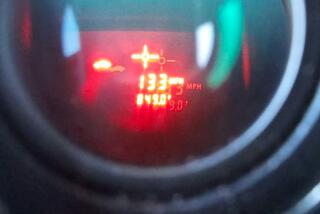Dear Street Smart:Recently you ran a question...
- Share via
Dear Street Smart:
Recently you ran a question and answer relating to the decrepit state of the speedometer check signs that are seen on rare occasions on our highways. I have a more fundamental question relating to those signs: How do you use them to check your speedometer?
I can understand how they might be used to check one’s odometer, but I don’t see how they easily can be utilized to match your actual speed against what is shown on the speedometer.
One method that occurs to me is to slow to 60 m.p.h. on your speedometer, then set your stopwatch and see if it takes you exactly five minutes to go from the 0 sign to the 5 sign. If it is less than five minutes, then I imagine your speedometer is understating your speed; if it is more than five minutes, then it would seem that the speedometer is overstating your velocity.
One problem I see with this technique is that if you slow to 60 m.p.h. on Interstate 5, you’ll be rear-ended by a semi. The other is that it’s quite complicated and distracting and I doubt that few, if any, people ever use it that way. Also, you’d have to be something of a math whiz to figure out how inaccurate your speedometer is using the method I described.
Therefore, I’m assuming that there is a simpler method than the one I came up with. If so, what is it? I’m also wondering why Caltrans goes to the expense of putting up those signs, but doesn’t do a better job of publicizing how they should be used.
Harold Watkins, Studio City
Dear Reader:
The signs of which you write are indeed difficult to use to check your speedometer. That’s because they are intended primarily for your odometer. Checking that is easy, as you point out. For each sign you pass, your odometer reading should be exactly one mile higher.
But as you also point out, checking your speedometer involves a steady foot, a stopwatch and at least an average mathematical aptitude. At 60 m.p.h., it should take you one minute to get from one sign to the next--or five minutes from beginning to end.
Yet, as Caltrans spokesman Russ Snyder points out, driving 60 m.p.h. is illegal on most highways in California. He assured us, however, that the signs could be used at 55 m.p.h.
He let us figure out how.
So, we figure that at 55 m.p.h. it should take you 65.8 seconds to go from sign to sign--or five minutes and 29 seconds to make the entire trip. Trust us on this one. We apologize for not showing our work.
As for calibrating how far off your speedometer is, there is a reason we write Street Smart instead of calculating missile trajectories. But we have found a simple method that usually bears satisfactory results. Back the car out of the driveway, drive it down the block to the nearest mechanic and ask him or her to have a look at it.
*
Dear Street Smart:
In the middle of a block, traffic is flowing in two directions, while at an intersection, traffic is coming from four directions. Obviously, it is safer to make a U-turn where one has to observe only two directions.
Yet in recent years, I have seen a dramatic increase in the number of people making U-turns at stoplight-controlled intersections. Do they know of a traffic law that I don’t?
Joseph Compton, Encino
Dear Reader:
Your fellow motorists may very well be more legally aware than you.
The drivers you see making U-turns at intersections are probably following the general rule of thumb that U-turns are almost always permissible at intersections unless a sign is posted prohibiting them.
In many cases the U-turns are protected by green left-turn arrows (although you should still watch for traffic from all sides). Even at intersections where U-turns aren’t protected, you can make one so long as it’s safe, says Bill Madison of the Department of Motor Vehicles.
Turning around in the middle of a block is trickier business, which is probably why so many motorists opt to wait for an intersection.
In a business district, it is completely illegal to hang a U--except at an intersection. In a residential area, a U-turn is allowable in the middle of the block, but only if no other vehicle is approaching from either direction within 200 feet.
“If you’re in doubt, don’t,” Madison advises.
One last caveat: Never make a U-turn in front of the driveway of a fire station. That’s illegal, according to the California Vehicle Code, and there are no exceptions.


